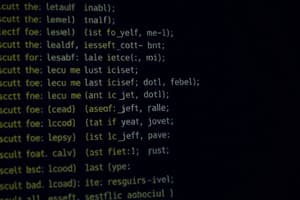Podcast
Questions and Answers
What value will planter hold after the line planter = (3 * 3 + 2)/3; executes?
What value will planter hold after the line planter = (3 * 3 + 2)/3; executes?
- 11
- 2
- 4
- 3 (correct)
What is the final value of planter before the printArray(planter) call?
What is the final value of planter before the printArray(planter) call?
- 8
- 6
- 16 (correct)
- 32
What will be printed to the console as a result of the call printArray(planter)?
What will be printed to the console as a result of the call printArray(planter)?
- The first element of the `garden` array.
- 16
- A sequence of memory addresses.
- The program will crash due to type mismatch. (correct)
What is the value of garden[i] inside the loop during the second call to function flower?
What is the value of garden[i] inside the loop during the second call to function flower?
What value is returned by the last call to function stem?
What value is returned by the last call to function stem?
Flashcards
Planter Value (Initial)
Planter Value (Initial)
Calculates (3 * 3 + 2) / 3 using integer arithmetic.
Planter Value (Modulo)
Planter Value (Modulo)
Sets planter to the remainder of 9 / 4.
Planter Value (Arithmetic)
Planter Value (Arithmetic)
Calculates 2 + 2 * 3 / 6 using integer arithmetic and sets planter to result.
planter += 2; planter *= 2; effect
planter += 2; planter *= 2; effect
Signup and view all the flashcards
printArray(planter) issue
printArray(planter) issue
Signup and view all the flashcards
Study Notes
- The C program includes three functions:
flower,stem, andmain, as well asprintArray, which is called but not defined - The
mainfunction initializes an integer variableplanterand an integer arraygardenwith values {2, 3, 1, 7} - An integer variable
iis initialized to 0 and used as a loop counter planteris assigned a series of values through arithmetic operations:
Planter Variable Changes
- Initially,
planteris assigned the value of(3 * 3 + 2)/3which evaluates to(9 + 2)/3 = 11/3 = 3(integer division) planterthen becomes the remainder of9 % 4, which is1- Next,
planteris assigned the value of2 + 2 * 3 / 6, which is2 + 6 / 6 = 2 + 1 = 3 planteris directly assigned the value6- The value of
planteris incremented by 2 (planter += 2), resulting inplanter = 8 planteris then multiplied by 2 (planter *= 2), resulting inplanter = 16- The
printArrayfunction is called withplanteras its argument, but due to type mismatch (passing anintwhere anint[]is expected) the behaviour is undefined. This is compiled without issue.
Print Array Function
- The
printArrayfunction is called with thegardenarray as its argument, though this function is not defined.
For Loop
- A
forloop iterates as long asiis less thanplanter(i < planter). - The loop calls the
flowerfunction, passing the current value ofias the argumentcolour - The returned value from
flower(i)is not stored or used - Inside the
flowerfunction, thestemfunction is called with the argumentcolour + 2, but the returned value is not stored or used
Flower Function
- The
flowerfunction takes an integercolouras input. - Inside
flower, thestemfunction is called withcolour + 2as its argument,
Stem Function
- The
stemfunction takes an integerleafas input. stemreturns the value ofleaf * 3
Program Issues
- The
printArrayfunction is called but not defined, resulting in a linker error unless a suitable definition exists in another compilation unit. - There is a type mismatch when calling
printArray(planter), asprintArrayexpects an integer array, but an integer is passed. - Values returned by
flowerandstemare never used - The array
gardenis defined but its elements are not referenced after being printed via theprintArraycall
Studying That Suits You
Use AI to generate personalized quizzes and flashcards to suit your learning preferences.




